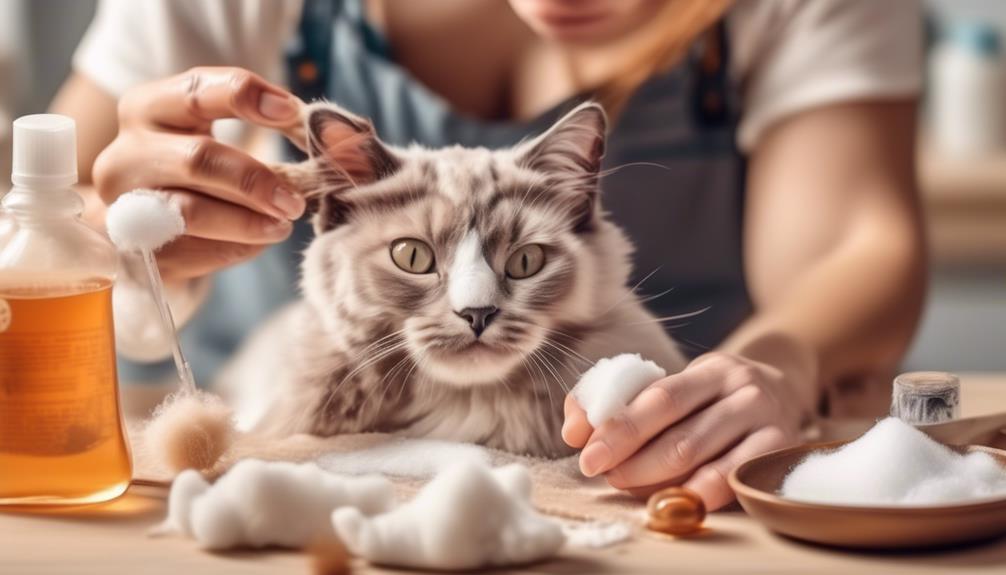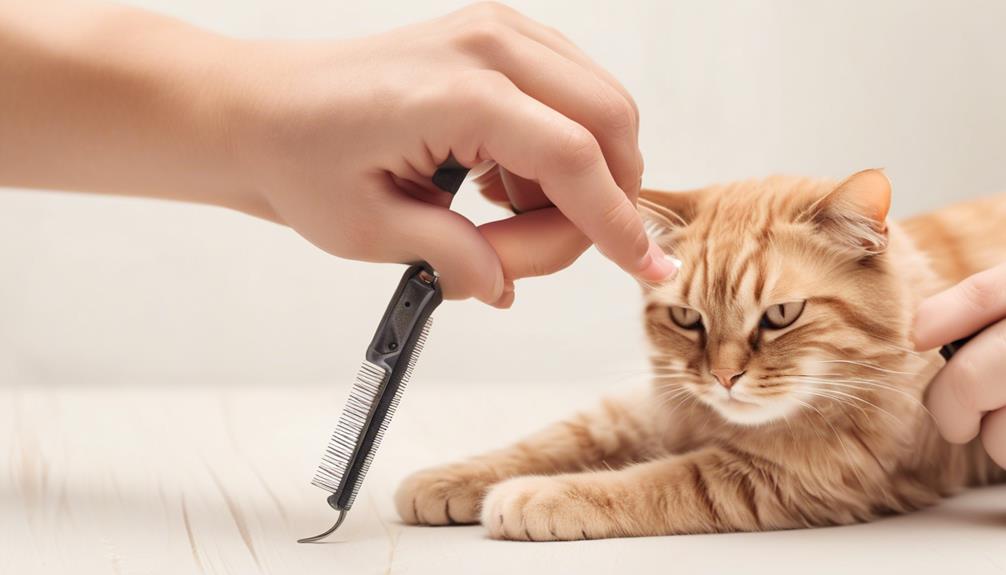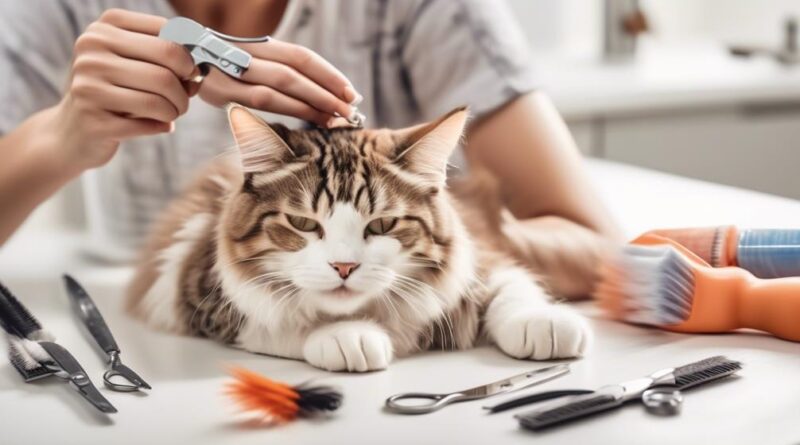15 DIY Tips for Successful Cat Grooming
Are you tired of the stress and expense of taking your cat to the groomer? Achieving professional-level grooming at home is easier than you might think.
With the right tips and techniques, you can keep your feline friend looking and feeling their best without the hassle of scheduling appointments or leaving the comfort of your home.
Whether you're a seasoned cat owner or a new pet parent, these 15 DIY grooming tips will help you master the art of cat care and grooming.
Homemade Cat Shampoo
To make your own homemade cat shampoo, consider using gentle, natural ingredients like oatmeal and mild baby shampoo for a soothing and effective cleaning experience. Oatmeal is known for its skin-soothing properties, making it an excellent choice for cats with sensitive skin. To create the shampoo, mix 1/2 cup of finely ground oatmeal with 1/2 cup of warm water and let it sit for a few minutes to thicken. Then add 1/2 cup of mild baby shampoo and mix well. This gentle homemade shampoo will help cleanse your cat's fur without causing any irritation.
When it comes to scenting your homemade cat shampoo, consider using essential oil alternatives such as lavender or chamomile. These essential oils are safe for cats and can provide a pleasant aroma to the shampoo without being overpowering. However, it's important to use essential oils sparingly and always dilute them properly before adding them to the shampoo mixture.
After shampooing your cat, you can also consider using herbal rinse options to condition their fur. An herbal rinse made from steeped herbs like rosemary or lavender can help to detangle fur and leave it soft and shiny. To make the herbal rinse, steep a handful of dried herbs in hot water for about 10-15 minutes, then allow the mixture to cool. After shampooing, pour the herbal rinse over your cat's fur, making sure to avoid their eyes and ears, and gently massage it in before rinsing thoroughly.
DIY Flea Treatment
If your cat is dealing with fleas, you can address the issue using natural methods that are safe and effective. Here are some DIY flea treatment tips to help keep your cat flea-free:
- Natural Flea Prevention: One effective method is to create a natural flea repellent spray using essential oils. Mix 2-3 drops of cedarwood or lavender essential oil with water in a spray bottle. Lightly mist your cat's fur, avoiding the eyes, ears, and mouth. These scents are unpleasant to fleas and can help repel them from your cat's coat. Additionally, regularly washing your cat's bedding in hot water can help eliminate flea eggs and larvae, reducing the risk of infestation.
- DIY Flea Control: Another effective DIY flea treatment is to use a flea comb regularly. Comb through your cat's fur, especially around the neck, tail, and belly. Have a bowl of soapy water nearby to immediately drown any fleas you comb out. This method helps physically remove adult fleas from your cat's coat and can provide immediate relief. Vacuuming your home frequently, especially areas where your cat spends time, can also help eliminate flea eggs and larvae from your environment.
Natural Cat Brushing Techniques
Regularly brush your cat's fur using a soft-bristled brush to help maintain a healthy coat and minimize shedding. This simple act not only keeps your cat looking tidy but also strengthens your bond with them. When brushing, use gentle detangling techniques to avoid causing discomfort to your cat. Start by brushing in the direction of hair growth, paying special attention to areas prone to matting, such as behind the ears and under the legs. If you encounter any tangles, approach them delicately to prevent causing any pain to your feline friend.
Incorporating organic grooming products can further enhance your cat's brushing experience. Look for natural, chemical-free options that are specifically formulated for feline fur. These products can help moisturize the skin, reduce static, and make the brushing process more enjoyable for your cat. Before using any grooming products, it's important to carefully read the labels to ensure they're safe for cats and free from harmful ingredients.
When brushing your cat, remember to approach the process with patience and gentleness. This not only helps in maintaining your cat's coat but also creates a calming and positive experience for both you and your furry companion. Regular brushing not only reduces shedding and prevents matting but also provides an opportunity for you to monitor your cat's skin and overall health. By incorporating gentle detangling techniques and organic grooming products, you can make the brushing experience more enjoyable and beneficial for your cat.
Homemade Cat Dental Care
For effective homemade cat dental care, consider incorporating natural dental treats and toys into your cat's routine. Taking care of your cat's dental health is crucial for their overall well-being. Here are some simple and effective homemade cat dental care tips:
- Breath Fresheners: Freshen up your cat's breath with natural breath fresheners. You can mix a small amount of chopped parsley into your cat's food, as it acts as a natural breath freshener. Another option is to add a few drops of chlorophyll to your cat's water, which can help combat bad breath.
- Tartar Control: Provide your cat with toys specifically designed to promote dental health. Look for toys that are designed to help control tartar and plaque buildup. There are also dental treats available that can help reduce tartar and promote good oral hygiene. Chew toys made of natural materials, such as rawhide or rubber, can also help keep your cat's teeth clean.
- Regular Brushing: Consider gently brushing your cat's teeth using a specially designed cat toothbrush and toothpaste. It's important to use toothpaste specifically formulated for cats, as human toothpaste can be harmful to them. Start by getting your cat used to the sensation of having their mouth touched, then gradually introduce the toothbrush and toothpaste into their routine.
Incorporating these homemade dental care tips into your cat's routine can help maintain their oral health and prevent dental issues down the line.
DIY Ear Cleaning Solutions

To continue caring for your cat's overall well-being, now let's address the topic of DIY ear cleaning solutions.
When it comes to keeping your cat's ears clean and healthy, natural ear cleansers and homemade ear care products can be effective and safe options. One of the simplest natural ear cleansers is a mixture of equal parts of organic apple cider vinegar and distilled water. This solution can help remove dirt and wax buildup from your cat's ears. Simply soak a cotton ball in the solution and gently wipe the visible parts of the inner ear.
Another homemade ear care product involves mixing a few drops of almond or olive oil with vitamin E oil. This mixture can help moisturize the ear canal and loosen any debris. After applying a few drops to the ear, gently massage the base of the ear to help the solution work its way in. Your cat may shake its head afterward, which is normal and helps to dislodge any loosened debris.
It's important to never insert cotton swabs or any sharp objects into your cat's ear canal, as this can cause injury. If your cat is showing signs of discomfort, has an odor coming from their ears, or if you notice redness or swelling, it's crucial to seek veterinary care.
Regular ear checks and gentle cleaning using natural solutions can contribute to your cat's overall grooming routine and well-being.
Natural Cat Hairball Remedies
Have you ever considered using natural remedies to help prevent hairballs in your cat? While hairballs are a common issue for cats, there are natural ways to reduce their occurrence and keep your feline friend comfortable. Here are some effective natural cat hairball remedies to consider:
- Dietary Changes: One of the most effective ways to prevent hairballs is by making dietary adjustments. Incorporating more fiber into your cat's diet can help move hair through the digestive system, reducing the likelihood of hairball formation. Look for high-fiber cat food or consider adding a small amount of canned pumpkin to their meals. Additionally, ensuring your cat stays well-hydrated by providing access to fresh water at all times can also aid in digestion and reduce hairball formation.
- Supplements: Certain supplements can help reduce hairballs in cats. Omega-3 fatty acids, found in fish oil supplements, can help maintain healthy skin and coat, reducing excessive shedding and the likelihood of hairballs. Consult with your veterinarian to determine the appropriate dosage for your cat.
- Natural Hairball Prevention Techniques: Regular grooming is key to preventing hairballs. Brushing your cat helps to remove loose hair before it can be ingested, reducing the amount of hair your cat swallows and minimizing hairball formation. Additionally, providing your cat with plenty of opportunities for exercise and play can help stimulate digestion and reduce hairball problems.
Homemade Cat Nail Trimming Tips

Considering your cat's grooming needs, maintaining their nails is essential for their overall health and well-being. Safe handling is crucial when it comes to trimming your cat's nails.
Start by getting your cat accustomed to having their paws touched. Gently hold and massage their paws while offering treats and positive reinforcement. This will help your cat feel more comfortable and less anxious during nail trimming.
It's important to use proper nail trimmers designed specifically for cats. Human nail clippers can cause splintering and discomfort. Ensure good lighting and have styptic powder or a styptic pencil on hand in case you accidentally trim the nails too short and cause bleeding.
Training tips are essential for successful nail trimming. Begin by letting your cat investigate the nail trimmers and get familiar with the tool. Once they're comfortable, gently press on their paws to extend the nails. Gradually introduce the sound of the trimmers without actually trimming. Reward your cat with treats and praise for staying calm during each step.
When you're ready to start trimming, do it slowly and carefully. Only trim the sharp tips and avoid cutting into the quick, the pink part of the nail that contains blood vessels. If your cat becomes agitated, take a break and try again later.
With patience and positive reinforcement, your cat will eventually become more cooperative during nail trimming sessions.
DIY Cat Grooming Wipes
You can create your own DIY cat grooming wipes using natural ingredients such as apple cider vinegar and aloe vera gel. These homemade cat grooming tools are gentle on your cat's skin and can help keep their fur clean and shiny.
Here's how you can make your own DIY cat grooming wipes:
- Gather the Ingredients: To make your DIY cat grooming wipes, you'll need a roll of strong paper towels, a container with a tightly fitting lid, apple cider vinegar, aloe vera gel, and water. Make sure to use organic, unfiltered apple cider vinegar and pure aloe vera gel without any added chemicals or dyes.
- Mix the Solution: In the container, mix equal parts of apple cider vinegar, aloe vera gel, and water. Gently stir the ingredients until they're well combined. The apple cider vinegar helps to cleanse and deodorize your cat's fur, while the aloe vera gel soothes and moisturizes their skin.
- Prepare the Wipes: Cut the paper towels to the desired size so that they fit into the container. Place the cut paper towels into the container and pour the DIY grooming solution over them. Allow the paper towels to soak up the solution, and then pull out the cardboard tube from the center of the paper towels. Your DIY cat grooming wipes are now ready to use!
These DIY cat grooming wipes are a convenient and affordable way to keep your feline friend looking and feeling their best.
Frequently Asked Questions
How Can I Train My Cat to Tolerate Grooming Sessions?
To train your cat to tolerate grooming sessions, use positive reinforcement and start slow. Gradually increase grooming frequency as your cat becomes more comfortable. Reward them with treats and praise to create a positive association with grooming.
Are There Any Specific Grooming Techniques for Long-Haired Cats Versus Short-Haired Cats?
When grooming long-haired cats, use shedding control techniques like regular brushing to prevent matting. For short-haired cats, focus on desensitization training to help them tolerate grooming. Tailor your approach based on your cat's specific needs.
What Are Some Signs That My Cat May Have a Skin or Coat Issue That Requires Professional Grooming?
If your cat shows signs like excessive scratching, hair loss, or skin irritation, it could indicate coat or skin issues. Such symptoms may require professional grooming help to address underlying problems and keep your cat healthy and comfortable.
Are There Any Specific Grooming Tools or Products That Are Not Safe for Cats?
When grooming your cat, it's important to prioritize safety. Avoid using human grooming products, as they may contain ingredients harmful to cats. Stick to cat-specific grooming tools and products recommended by your veterinarian for a safe grooming experience.
What Should I Do if My Cat Becomes Extremely Stressed or Aggressive During Grooming?
If your cat becomes extremely stressed or aggressive during grooming, try managing stress by using calming techniques like giving treats, using soothing tones, and taking breaks. Seek professional help if the behavior persists.
Conclusion
Now that you have these DIY cat grooming tips, you can keep your furry friend looking and feeling their best at home.
With homemade shampoo, flea treatments, and dental care, you can save money and ensure your cat's health and well-being.
Remember to always be gentle and patient when grooming your cat, and they'll surely appreciate the love and care you provide.
Happy grooming!
